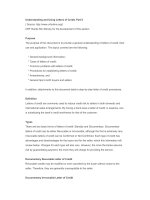Tài liệu Golf and the game of leadership 3 ppt
Bạn đang xem bản rút gọn của tài liệu. Xem và tải ngay bản đầy đủ của tài liệu tại đây (230.26 KB, 10 trang )
10
Golf and the Game of Leadership
practice the advice and wisdom contained in these pages. It will
help. But, if you really want to excel, you will really believe it in
your heart and gut. You will fall in love with the game! You will
seek to play the leadership game with the dedication of the avid
golfers portrayed in the following examples.
A television commercial played over and over again a few
years ago showed a golfer sitting on a bench in a small
three-sided shelter covered by a roof. He is alone with his
golf clubs. It is raining. No, it is pouring! He continues to wait.
Another golfer arrives. They agree to partner-up. They opti-
mistically observe, ‘‘it’s letting up some.’’ The downpour
continues. They sit on the bench. Waiting.
Roger Maltbie, the TV golf commentator and former PGA
professional, did a television special about the bands of
golfers—especially those in large metropolitan areas—who
vie for weekend tee times at public courses. This includes
waiting for the opening of morning registration by literally
spending the night in line. Pity them and their perseverance
when they suffer the fate of the golfers in the television
commercial.
On balmy weekday afternoons during spring, summer, and
fall, people across the country who are supposed to be
working show up for a round of 18. Sunday church atten-
dance drops with the advent of good golfing weather.
What brings these people out? What causes them to so want
to play the game of golf? In a word, MOTIVATION! Golfers are
motivated by the game they love to play, the game that never
ceases to challenge. There are millions of us. And the numbers
keep growing.
Love It Too Much?
In November of 1862, the Union Army of the Potomac under
General Burnside was preparing to cross the Rappahannock River,
.......................... 10589$ $CH1 02-23-04 16:44:15 PS
11
You’ve Gotta Love the Game
capture Fredericksburg, and move on to Richmond. Burnside was
delayed several days awaiting delivery of the pontoon bridges
needed to cross the river. The delay allowed General Robert E. Lee
to bring in reinforcements and to set up a defense on the south
side of the river, where Lee felt he could contain the superior
Union forces.
When Burnside began his assault, it was too late. Lee’s de-
fenses worked perfectly. The Union army was badly defeated, and
Burnside’s surviving forces retreated to Washington. After the bat-
tle, Lee and his staff inspected the considerable damage done to
Fredericksburg. Upon seeing the ruins, Lee observed to his staff,
‘‘It is good that war is so horrible. If it were not we should grow
to love it too much!’’
Motivation or Movement
You and I have observed people succeed and fail in the organiza-
tional workplace. Success or failure, given the ability to perform,
rests on more than going through the motions to reach a goal or
earn a paycheck. What is it that motivates people, most impor-
tantly leaders, to perform to the best of their ability. What causes
them to love what they do?
One of the questions most frequently asked by aspiring lead-
ers is ‘‘how do I motivate my people?’’ First, we need to under-
stand that people follow leaders either because they are internally
or externally moved to do so. Figure 1-1 illustrates this distinc-
tion. We can pull or push people to do what needs to be done.
Both can be hard work. Both can be unsuccessful. Ideally they will
want to do it, that is, they are internally motivated.
Many leaders believe they have people skills and that they can
use them to motivate others. They cannot! What they can do is
attempt to establish a motivational environment that will, we
hope, influence the desired behavior. Individuals control their
own motivation. You do, so do I. Sure, golfers can be pulled, or
pushed, into waiting for the rain to stop, or waiting in line before
dawn for a tee time, or skipping work to play golf, but they’ve got
.......................... 10589$ $CH1 02-23-04 16:44:16 PS
12
Golf and the Game of Leadership
FIGURE 1-1.
External movement and internal motivation.
1. People can be pulled in a direction.
2. People can be pushed in a direction.
3. People respond to internal motivation.
to want to do it to enjoy it and do their very best. They respond
to an internal motivation, so do your followers.
Herzberg’s Theory
Dr. Frederick Herzberg, who developed a classic theory of motiva-
tion in the workplace, is remembered as one of the most influen-
tial management teachers of our time. In 1995, Herzberg’s book,
Work and the Nature of Man, was listed as ‘‘one of the ten most
.......................... 10589$ $CH1 02-23-04 16:44:17 PS
13
You’ve Gotta Love the Game
important books impacting management theory and practice in
the twentieth century.’’ His 1968 Harvard Business Review article,
One More Time: How Do You Motivate Employees, most recently
reissued in January 2003, is the all-time best-selling HBR reprint
by thousands of copies.
I had the pleasure of meeting Fred Herzberg and introducing
him to a group of several hundred General Motors leaders in Day-
ton, Ohio. I am convinced he was not thinking about the game of
golf as he developed his theory of motivation in the workplace.
But I am equally certain that he was thinking about how to gener-
ate in the organizational workplace the zeal represented by an
enthusiastic golfer. In my opinion, Herzberg’s theory stands to
this day as the most practical, realistic, logical, common-sense yet
academically sound, analysis of the subject.
Herzberg’s theory states that an individual’s motivation is
influenced by ‘‘hygiene’’ and ‘‘motivation’’ factors. The hygiene
factors in an organization—also referred to as maintenance fac-
tors—are such things as company policy and administration, lead-
ership and supervision, working conditions, salary, and job
security.
People expect hygiene factors to be appropriately provided.
Hygiene factors possess little potential for motivation. They are
expected. If they are not provided, people will be unhappy and
dissatisfied. Provide them and people will not be happy and satis-
fied. They will simply not be unhappy and not dissatisfied.
Motivation Factors
Herzberg’s motivation factors involve what we ask people to do
and include the following:
■
Achievement
■
Recognition
■
Responsibility
■
Growth
■
Challenging Work
These factors, together with acceptable hygiene factors, can
result in satisfaction on the job. Achievement and recognition are
.......................... 10589$ $CH1 02-23-04 16:44:18 PS
14
Golf and the Game of Leadership
short-term motivators and need repetition. Awards, promotions,
and merit salary increases are good examples. We appreciate them
but quickly revert to ‘‘what have you done for me lately.’’ Respon-
sibility, growth, and challenging work are longer lasting. Interest-
ingly, motivated people do not necessarily experience all of the
motivational factors. Some can be motivated by the work they do
but not experience growth or added responsibility. Although their
efforts may not be recognized, they are satisfied with their own
measurement of their achievements. For example, many golfers
are motivated simply by the challenge and the joy of playing the
game.
When the motivation factors are not being met, people will
stress the hygiene or maintenance factors. When motivation fac-
tors are met, people tend to view hygiene factors as being less
important. The most powerful motivational factor is challenging
work. If we look, for example, at the auto industry, it is easy to
understand the lack of motivational opportunity offered an as-
sembly line worker. Hence, in that industry people stress mainte-
nance factors. If leaders provide only the hygiene factors they can
expect minimal effort, mediocre performance, and in a highly
competitive world, results that don’t ‘‘make the cut.’’ Provide the
maintenance factors together with the motivation factors and you
will increase your chances of getting spirited effort, extraordinary
performance, and results that put you and your team on ‘‘the
leader board.’’ Figure 1-2 is an illustration of the Herzberg theory
applied to our golfing metaphor.
The impact of Herzberg’s theory on the leader intent on creat-
ing and sustaining a motivational organization environment is
clear. Southwest Airlines, one of the most successful U.S. airlines
of the past fifteen years, appears to put life in Herzberg’s theory.
Joan Magretta, in her book, What Management Is: How It Works
and Why It’s Everyone’s Business, comments that under the leader-
ship of President Herb Kelleher, Southwest’s culture has been re-
sponsible for keeping employees happy, satisfied, dedicated, and
energetic. The idea that work should be fun is one of Southwest’s
core values. The company also adheres to the notion that every
.......................... 10589$ $CH1 02-23-04 16:44:18 PS









